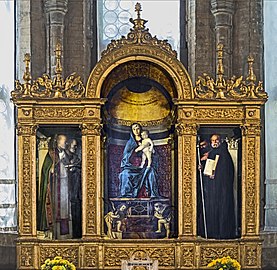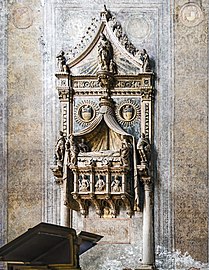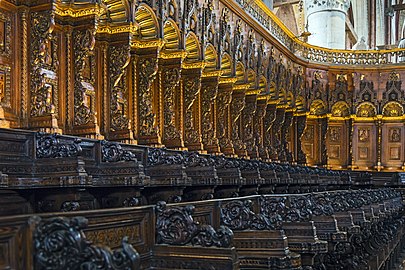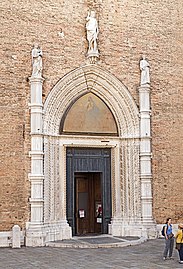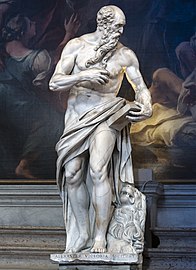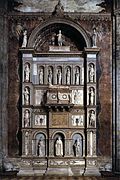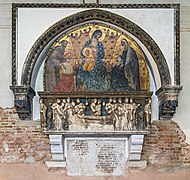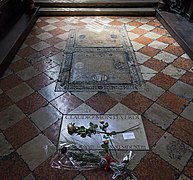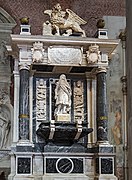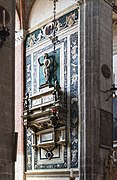Santa Maria Gloriosa dei Frari
This article needs additional citations for verification. (November 2022) |
| Basilica di Santa Maria Gloriosa dei Frari | |
|---|---|
 East front of Santa Maria Gloriosa dei Frari with the bell tower | |
 Click the map for an interactive, fullscreen view | |
| 45°26′12″N 12°19′34″E / 45.43667°N 12.32611°E | |
| Location | Venice |
| Country | Italy |
| Denomination | Roman Catholic |
| Architecture | |
| Architectural type | Church |
The Basilica di Santa Maria Gloriosa dei Frari, usually just called the Frari, is a church located in the Campo dei Frari at the heart of the San Polo district of Venice, Italy. The largest church in the city, it has the status of a minor basilica. The church is dedicated to the Assumption of Mary.
The imposing edifice is built of brick, and is one of the city's three notable churches still mostly retaining their Venetian Gothic appearance. In common with many Franciscan churches, the exterior is rather plain, even on the front facade. The exterior also features a bell tower that was fixed in the early 2000s after going through structural problems. The interior is notable for many very grand wall monuments to distinguished Venetians buried in the church, including a number of Doges and the painter Titian. Many of these are important works in the history of Venetian sculpture, and the many paintings include two large and important altarpieces by Titian, the Assumption of the Virgin on the high altar and the Pesaro Madonna. It also contains the only rood screen still in place in Venice.
History
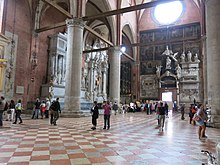
In 1231, under Doge Jacopo Tiepolo, the city donated land at this site to establish a monastery and church belonging to the Franciscan Order of Friars Minor. This edifice proved too small and a three nave church was begun in 1250, and not completed until 1338. Work almost immediately began on its much larger replacement, the current church, which took over a century to build. The new church inverted the original orientation, thus placing the facade facing the plaza and small canal. The work was started under Jacopo Celega, but completed by his son Pier Paolo. The campanile, the second tallest in the city after that of San Marco, was completed in 1396. Under the patronage of Giovanni Corner, the Chapel of San Marco was added in 1420. In 1432-1434 the bishop Vicenza Pietro Miani built the chapel of San Pietro next to the bell-tower. The facade was not completed until 1440, with the cornice is surmounted by three statues (1516) by Lorenzo Bregno The main altar was consecrated in 1469. In 1478, the Pesaro family commissioned a chapel in the apse. On 27 May 1492, the church was consecrated with the name of Santa Maria Gloriosa.
The Frari is a parish church of the Vicariate of San Polo-Santa Croce-Dorsoduro. Other churches of the parish are San Barnaba, San Ludovico Vescovo, Santa Maria del Soccorso and Santa Margherita. In the 16th century, however, devotional life changed in a big way; being private, less moral, and contained people from various countries. The congregations got big only when a famous preacher was preaching, or a major feast was taking place. All connections had a relationship with the brotherhood involved in the chruch, as most of the other chapel areas were designed for private groups. This church is notable to hosting funerals and other gatherings for the deceased. Also, in later times, there was some crime and mischief going on with the church.[1] As a result, the Franciscans had been expelled from the church during the 19th century, the church was restored to the order in 1922.The bell tower went through a structural intervention from 1904 to the 1990s that helped fix the cracks in the bell tower.[2]
Titian, the most prominent 16th-century Venetian painter, is interred in the Frari.
Choir Screen
In 1475, a choir screen was built at the Santa Maria Gloriosa dei Frari so that during the service, the monks were separated from everyone else. The change in styles was the only way the choir screen was making progress towards completion. That screen remained the only choir screen in Venice as of today. The front of the screen has a lot of Gothic influence, especially in the late Gothic era. Some of the styles on the screen today were in historical Venetian fasion. Some styles even have a Classical influence, such as the leaves that were formed on the pilasters. The screen had an inscription on the front that was created in addition to the main curtain screen that came from the Romans. The design of the screen had works that influenced from other churches, such as San Zaccaria, Ss. Giovanni E Paolo, and San Michele in Isola.[3]
Architectural Features
The church overall is Venetian Style, as the walls were made of red brick, the beams were decorated on the inside and details were made of Istrian stone. It also has Roman influence, because the columns in the nave contain large cylindrical shafts. The church also contains six smaller chapels as well as the main chapel, three on each side of the main chapel. The baptistery and sacristy were featured along with two other chapels, making the church a family chapel.[1]
The church overall has a vaulted Gothic rib ceiling, making the interior's volume large. The church does not have a dome in the middle, making it unique. The materials used were mostly hard and resonant, from marble and Istrian stone tile floors, to masonry walls and vaults with brick covered with intonaco.[1]
Bell Tower Structural Intervention
Cracks started to form on the bell tower in 1904 after St. Mark's bell tower collapse, leading to a structural intervention. The investigation of the Frari bell tower started in 1990, with structural problems taking place in 2000. The tower was investigated deeply in 2001-2003, and used a monitoring system to identify crack patterns. The stress was also measured using Flat jack testing. Overall, the tower was inspected geotecnically very well, including using standard penetration tests, and digging through the bell tower foundation. A structural analysis of the bell tower was then performed, and the forces and loads were calculated to fix the tower. After the investigation, several instruments, including a crack-gauge and a strain gauge were used to keep track of the work on the bell tower in real time.[2]
Strengthening interventions were conducted to keep the tower safe, and it was used with a structural/geotechnical monitoring system. The first phase involved using a steel cable connecting one of the columns to the bell tower for the Frari. The second phase involves injecting mortal into the soil, and the soil is strengthened due to increased stress. The most information came from the direct bell tower and precision leveling. The mortar was grouted to determine the velocity of the different intervention phases. At the end, the settlement velocity decreased. The third and final phase involves a structural joint between the tower and the church. Even though it took six months to execute, it worked pretty well as it prevented damage to the bell tower and parts of the church. Even though it resulted in tower deformations, It was one of the big moves in the bell tower. Overall, soil-fracture intervention and structural joint execution both use the direct pendulum. The structural joint helps avoid future cracks when seismic loads occur.[2]
Pipe organs
This section may require cleanup to meet Wikipedia's quality standards. The specific problem is: Not well formatted. (December 2021) |
History The first news about the organ in the Frari basilica dates back to the 15th century. In fact, in 1483 a chronicle of the convent refers to the existence of a "perfectum" organ. Girolamo Diruta (1586-1589) and Giovanni Picchi in service for over thirty years, probably from 1593 at least until 1629, are among the most famous organists of the basilica.
An engraving depicting the choir of the basilica, made by Father Vincenzo Coronelli in 1708, shows that at that time the basilica had two organs placed sideways on the choir stalls, facing each other, on the perimeter wall of the choir.
The left organ was probably built by Giovan Battista Piaggia in 1732, this instrument could therefore be one of his first works. The activity, known up to now, of this Venetian organ builder extends, in fact, from 1740 to 1760, the organ he built for the Venetian church of San Giovanni Evangelista dates back to that date and has remained almost unchanged; the latter therefore served as a term of comparison to validate the attribution of that of the Frari and, above all, to allow its reconstruction in 1970. In fact, after Gaetano Callido had built the front organ (1795), this instrument was progressively abandoned, so as to reach the early seventies almost completely stripped of the metal rods.
The right organ was built by Gaetano Callido in 1795/96. Almost uninterrupted documentation, up to the early decades of the twentieth century, allows us to know how this instrument, unlike the other, was entrusted to qualified organ builders for ordinary maintenance and, from time to time, restored with substantial respect for its authenticity.
The problem of restoring the two ancient organs was faced only in 1969, in fact, after the construction of the new Mascioni organ with electropneumatic transmission (1928), an organ located in the apse close to Titian's Assumption, the use of the Callido organ it decreased over time and, so much so that between 1929 and 1969 there were no maintenance interventions.
The restoration of the organs involved for the right organ, given the good conditions of conservation and integrity, an intervention of extraordinary maintenance; while a more radical intervention concerned the left organ, in practice, a reconstruction in the strict sense, since there were seven façade pipes, all the internal mechanics, nine wooden pipes and a bellows missing. For this reconstruction all the surviving elements were used and, on the basis of these, also making comparisons with the organ of San Giovanni Evangelista, the measures of the pipes were established.
The restoration made it possible to appreciate again the round and robust sounds of the Callido organ and the transparent and delicate timbre of the Piaggia organ, closer to Renaissance sound models. The instruments were eventually tuned in unison to be played together. After more than thirty years, a new revision work was promoted, which was completed in the months of April and May 2004.
The practice of the double choir is re-proposed in the basilica of the Frari, thanks to the availability of the two organs placed on two opposing choirs, typical of a musical style in vogue in Venice in the sixteenth and seventeenth centuries, that of the Frari is the last surviving example in Venice - and one of the rare in Italy - of two choirs with functioning historical organs.
Piaggia organ
Piaggia organ The organ of the left choir, with original integral mechanical transmission, has a single keyboard of 45 notes with a first octave scavezza (C1-C5) and a pedalboard of 13 (C1-E2) with a first octave scavezza, constantly combined with the manual. . The exhibition consists of 21 pipes, belonging to the main register and forming a single cusp with side wings and with aligned shield mouths. The phonic arrangement, based on the position of the knob tie rods of the various stops in a column of the register (whose handwritten tags are original), is as follows:
- Main 8 '
- Octave
- Tenth Fifth
- Tenth Ninth
- Second Vigesima
- Vigesima Sixth
- Vigesima Nona
- Human Voice
- Twelfth flute
- Handset
- Double basses 16 '(always inserted)
Callido organ
Callido organ On the right choir there is the pipe organ built by Gaetano Callido, it has an original integral mechanical transmission; it has a single 47-note keyboard with first octave scavezza (C1-D5) and a 17 + 1 pedalboard (C1-G # 2 + Rollante pedal) with first octave scavezza, constantly combined with the manual. The exhibition consists of 21 pipes, belonging to the main register and forming a single cusp with lateral wings and with aligned miter mouths, at the foot of which the tromboncini are housed. The disposition
The basilica also housed the Mascioni opus 398 pipe organ, built in 1928.
It was placed behind the Assunta altarpiece of the main altar, it was electrically driven, had three keyboards of 61 notes each (C1-C6) and a pedalboard of 30 (C1-F3).
It was the largest organ in Venice, the only one with three manuals from the Cecilian period, the only instrument that allowed the performance of concerts with a repertoire that could range from the Romantic to the contemporary period.
Despite the transformation of the transmission from pneumatic to electric, the organ preserved all the pipes (about 2000), the bellows and the wind chests (with the exception of that of the third manual which was destroyed by high water during the restoration of the Pala Assunta in the 1960s), the beautiful wooden console table, with its original ivory keys.
In 2018, the organ, fully functional and active in liturgies and concerts, was disassembled to allow the complete restoration of the altarpiece and frame of the Assumption, with no idea of where to place it at the end of the restoration of the painting. In 1965 it had already been dismantled to allow the restoration of the altarpiece in a previous intervention, once restored, the organ had been rebuilt in 1977, many parts were destroyed, including the wind chest of the 3rd manual, but many other patios were resumed and reassembled because they were missing, some registers from the same period also made by Mascioni, the patient work was performed by Maestro Alessandro Girotto, the completed organ was inaugurated with a concert by the concert master Sergio De Pieri, then organist of the basilica. Now, however, the instrument has been generously donated to the parish church of Santa Maria Ausiliatrice in Lido di Jesolo (Venice) where it will be mounted (perhaps in 2022?) After the restorations and tampering necessary to try to adapt it to the new different location by of the Zanin di Codroipo company, leaving the city of Venice deprived of its only romantic-symphonic concert instrument.
Interior plan

The plan of the church looked like a typical Gothic cathedral, as it was shaped like a Latin cross, and featured aisles on the sides.[1] The list below indicated what is located on the image of the plan, shown below.
- - Counter-facade
- - Chapel of the Crucifix
- - Canova Monument
- - Doge Pesaro Monument
- - Chapel with Pesaro Madonna by Titian
- - Chapel of San Pietro
- - Chapel of San Marco
- - Chapel of the Milanesi
- - Chapel of San Michele
- - Chapel of the Franciscan Saints
- - Choir and Organ
- - Presbitery
- - Doge Tron Monument
- - 12th-century Crucifix
- - Assumption of Virgin, main altarpiece by Titian (and main organ)
- - Monumento al Doge Foscari
- - Chapel of San Giovanni Battista
- - Chapel of Father Kolbe
- - Chapel of Bernardo
- - Dead Christ
- - Altar of the Sacristy with Giovanni Bellini's Frari Triptych
- - Sacristy
- - Altar of the Relics
- - Entry to Sala del Capitolo and Convent
- - Wall of right transept
- - Jacopo Marcello Monument
- - Altar of Santa Caterina
- - Altar of San Giuseppe da Copertino
- - Altar with Presentation of Jesus at the Temple
- - Titian Monument
- - Altar of Sant'Antonio da Padova
Works of art
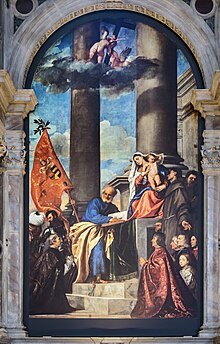
- Assumption of the Virgin by Titian
- Titian, Pesaro Madonna on the north wall of the nave
- Antonio and Paolo Bregno, tomb of Doge Francesco Foscari in the chancel (attributed; may actually be by Niccolò di Giovanni Fiorentino)
- Lorenzo Bregno, tomb of Benedetto Pésaro above the sacristy door
- Girolamo Campagna, statuettes of St. Anthony of Padua and St. Agnes on the water stoups in the nave
- Marco Cozzi, choir stalls in ritual choir
- Donatello, figure of St. John the Baptist in the first south choir chapel, Donatello's first documented work in Venice
- Tullio Lombardo, tomb of Pietro Bernardo on the west wall (attributed; may actually be by Giovanni Buora)
- Antonio Rizzo, tomb of Doge Niccolò Tron in the chancel
- Jacopo Sansovino, damaged figure of St. John the Baptist on the font in the Corner Chapel
- Palma il Giovane, Martyrdom of St. Catherine from Alexandria / Martirio di santa Caterina d’Alessandria (1590-1595)
- Paolo Veneziano, Doge Francesco Dandolo and His Wife Presented to the Virgin by Ss. Francis and Elizabeth in the sacristy
- Alessandro Vittoria
- Giambattista Pittoni, Hagar in the desert, Oil on Canvas, sacristy
- Bartolomeo Bon's workshop, figures of the Virgin and St. Francis on the west front
- figure of The Risen Christ on the west front
- figure of St. Jerome on the south wall of the nave
- Alvise Vivarini, St. Ambrose and other Saints in the north transept chapel, his last work
- Bartolomeo Vivarini
- St. Mark Enthroned in the Capella Corner in the north transept
- Madonna and Child with Saints, altarpiece in the third south choir chapel
-
Giovanni Bellini, Madonna and Child with Ss. Nicholas of Bari, Peter, Mark and Benedict
-
Giambattista Pittoni, Hagar in the desert
-
Bartolomeo Bon the Virgin and St. Francis on the west front
-
Lorenzo Bregno tomb of Benedetto Pésaro
-
Girolamo Campagna,St Anthony of Padua
-
Girolamo Campagna, St Agnes
-
Choir stalls by Marco Cozzi
-
Donatello, St. John the Baptist
-
Tullio Lombardo, tomb of Pietro Bernardo
-
Antonio Rizzo, tomb of Doge Niccolò Tron
-
Jacopo Sansovino, St. John the Baptist
-
High altar showing Assumption of the Virgin by Titian
-
Paolo Veneziano, Doge Francesco Dandolo and His Wife Presented to the Virgin by Ss. Francis and Elizabeth
-
Alessandro Vittoria The Risen Christ
-
Alessandro Vittoria St. Jerome
-
Alvise Vivarini St. Ambrose and other Saints
-
Bartolomeo Vivarini St. Mark Enthroned
-
Bartolomeo Vivarini Madonna and Child with Saints
Funerary monuments
- Francesco Barbaro (1390–1454) (humanist and senator)
- Pietro Bernardo (d. 1538) (senator)
- Antonio Canova (only his heart is buried here; the tomb, realised by his disciples, is based on the drawing of Canova himself for an unrealised tomb for Titian)
- Federico Cornaro
- Doge Francesco Dandolo (in the chapter house)
- Doge Francesco Foscari (d. 1457)
- Jacopo Marcello
- Claudio Monteverdi (one of the greatest composers of the 17th century, Chapel of the Milanese )
- Beato Pacifico (founder of the current church)
- Alvise Pasqualigo (d. 1528) (Procurator of Venice)
- Benedetto Pésaro (d. 1503) (general)
- Doge Giovanni Pesaro
- Bishop Jacopo Pésaro (d. 1547)
- Paolo Savelli (condottiere) (the first Venetian monument to include an equestrian statue)
- Titian (d. 1576) (Renaissance painter)
- Melchiorre Trevisan (d. 1500) (general)
- Doge Niccolò Tron
-
Monument to Antonio Canova
-
Monumento to Doge Niccolò Tron
-
Monument to Federico Cornaro
-
Monumento to Doge Francesco Dandolo
-
Monument to Jacopo Marcello
-
Tomb of Claudio Monteverdi
-
Monument to Blessed Pacifico
-
Monument to Alvise Pasqualigo
-
Monument to Doge Giovanni Pesaro
-
Monument to Jacopo Pesaro
-
Monument to Paolo Savelli
-
Monument of Titian
-
Monument to Almerico d'Este
-
Monument to Melchiorre Trevisan
See also
References
- ^ a b c d Howard, Deborah (2009). Sound and space in Renaissance Venice : architecture, music, acoustics. Yale University Press. ISBN 978-0-300-14874-9. OCLC 799553526.
- ^ a b c Lionello, Alberto; Rossi, Christian; Rossi, Pier Paolo (2015), Toniolo, Lucia; Boriani, Maurizio; Guidi, Gabriele (eds.), "Testing and Monitoring for the Control of Strengthening Interventions of Santa Maria Gloriosa Dei Frari in Venice", Built Heritage: Monitoring Conservation Management, Cham: Springer International Publishing, pp. 113–125, doi:10.1007/978-3-319-08533-3_10, ISBN 978-3-319-08533-3, retrieved 2022-11-12
- ^ Lieberman, Ralph (1982). Renaissance Architecture in Venice 1450-1540. New York: Abbeville Press. ISBN 0-89659-310-X.
External links
- Official website (in Italian)
 Santa Maria Gloriosa dei Frari travel guide from Wikivoyage
Santa Maria Gloriosa dei Frari travel guide from Wikivoyage
| Preceded by Santa Maria della Salute |
Venice landmarks Santa Maria Gloriosa dei Frari |
Succeeded by Santi Giovanni e Paolo |

